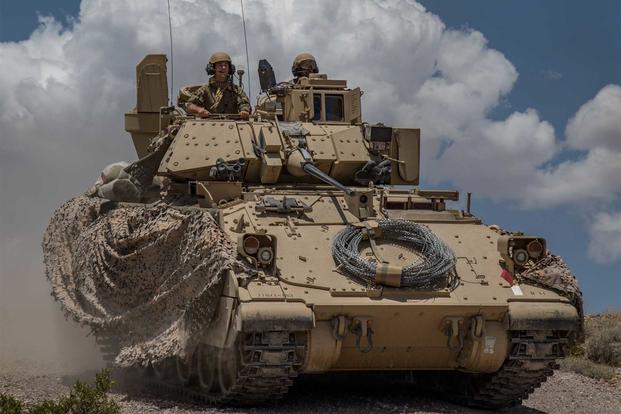Army modernization leaders faced tough questions Thursday from lawmakers who worry that the decision to restart the Optionally Manned Fighting Vehicle (OMFV) effort has destroyed the trust of defense firms that have already invested millions in the Bradley fighting vehicle replacement.
Army officials announced in late January that the service would restart the high-priority OMFV effort after receiving only one valid bid for the $45 billion program.
Rep. Donald Norcross, D-New Jersey, chairman of the House Armed Services Committee's Tactical Air and Land Forces subcommittee, said many lawmakers are concerned about the impact the Army's decision will have on defense firms who made a "tremendous investment" trying to develop prototypes for OMFV.
"We asked them to make an investment, and now we are switching," Norcross said. "How do we keep saying to our industrial base, 'OK, that was a screw-up. Your investments are not lost'? It's a risk; we understand. They knew it going in, but it doesn't help our case that this is the new way that we are going to do things."
Related: The Army Is Headed Back to the Drawing Board on Bradley Fighting Vehicle Replacement
Bruce Jette, assistant secretary of the Army for acquisitions, logistics and technology, along with Gen. John Murray, commander of Army Futures Command, told lawmakers that the service is still committed to OMFV.
"I just want to make sure you understand this was not a quick or easy decision where we decided to restart the program," Murray said. "We went through probably two, three, four weeks of discussion ... with the Army senior leadership. It was not an easy decision."
Army officials say the service has no choice but to replace the Cold War-era Bradley, which is no longer upgradeable to meet modern threats.
The OMFV, which is part of the Next Generation Combat Vehicle effort, suffered a setback when it received only one qualifying bid from General Dynamics. A competing bid from Raytheon and Germany's Rheinmetall was disqualified when Rheinmetall failed to ship a prototype of its Lynx KF41 Infantry Fighting Vehicle to the U.S. by the service's deadline.
Army officials admit that the service may have rushed the prototyping effort, which discouraged many companies from competing.
"We were trying to go so fast that we asked for vehicle deliveries of prototypes at the very beginning. ... That itself kept people out of competition," Jette said.
The Army's new approach to OMFV will "lower the bar" for the amount of investment companies need to put into the effort, he said.
The service is asking defense firms to submit white papers on a digital design instead of "bending metal" to build prototypes, Jette said. "So, in this case, going to a digital design requires them to be professional in their engineering capabilities but doesn't require them necessarily to bend metal."
Army leaders maintain that they have given industry a set of operational characteristics that can be revised as the program evolves rather than rigid requirements that may be too difficult to achieve.
"We've added some characteristics there in particular with weight: How do you reduce weight on the weapon system? We'll see what ideas they have," Army Secretary Ryan McCarthy told reporters Wednesday at the McAleese 11th Annual Defense Programs Conference. "You know, can you bring additive manufacturing? Can you find different ways to configure the vehicle to yank weight off the platform?"
Norcross pushed for an answer about how defense firms have reacted to this new approach.
"Industry made a sizable investment. They now hear what you are talking about now -- are they going to continue this and be partners?" he asked. "Where is industry with this, because I know what we have heard and it hasn't been pretty. They feel that ... we could have done this many millions of dollars sooner."
Jette said he is aware of industry's concerns after meeting with major vehicle manufacturers last week.
"I had this discussion with them. I understand that it's a sting," he said. "I also understand that some of the things that they have done are still viable and useful in the next phase. So far, my estimate is that at least what I would consider the standard competitors are still intending to participate."
Jette added that about 11 additional companies have also indicated to OMFV program officials that they are interested in participating as well.
Rep. Paul Mitchell, R-Michigan, said he continues to be frustrated that the Army has not explained how the setback will affect the OMFV's schedule and overall costs.
"I am concerned that I haven't got an adequate explanation of the abrupt cancellation of the procurement and what that does to the schedule -- what delays that creates in the schedule?" he said. "No one has answered what the cost delays will be. Frankly, I have gotten a whole lot of discussion around it. I am not going to ask you to address it here. I am going to ask you to address it for the record. We want an answer for the record. It's an issue of concern for many people here."
Army Chief of Staff Gen. James McConville said in January that the system should be ready for fielding in two or three years.
McCarthy said Wednesday that the service wants to release a new request for proposal "as soon as possible to try to make up for [time] that was lost."
-- Oriana Pawlyk contributed to this story.
-- Matthew Cox can be reached at matthew.cox@military.com.
Read More: Army Studying Whether M1 Tank Replacement Should Be Driver-Optional












